FAQ - Advanced Bathroom Queries
What Causes a Toilet to Flush Slow

Did you know that a slow-flushing toilet is a common problem in many households? It can be frustrating and inconvenient when you’re in a hurry or have guests over.
In this article, I will explore the various causes of a slow-flushing toilet and provide you with practical solutions. From common blockages and faulty flappers to inadequate water supply and clogged vent pipes, understanding these issues will help you troubleshoot and fix the problem efficiently.
So, let’s dive in and get your toilet flushing smoothly again!
Key Takeaways
- Common blockages, such as debris, toilet paper, foreign objects, and septic tank issues, can cause a toilet to flush slowly.
- A faulty flapper, with issues like being defective, worn-out, warped, cracked, or with mineral deposits, can also lead to slow flushing.
- Inadequate water supply, often caused by low water pressure due to plumbing leaks, can result in incomplete or weak flushes.
- A clogged vent pipe can cause slow flushing, highlighting the importance of regular inspection and cleaning to prevent blockages.
Common Blockages
If you notice that your toilet is flushing slow, one common cause could be a blockage in the pipes. Pipe obstructions can occur due to various reasons, such as the accumulation of debris, toilet paper, or even foreign objects that accidentally find their way into the toilet bowl. These obstructions restrict the flow of water, leading to slow flushing.
Another issue that can contribute to slow flushing is septic tank problems. When the septic tank is full or experiencing issues, it can affect the flushing performance of your toilet. In such cases, it is crucial to address the blockages promptly.
Regular maintenance, proper disposal of waste, and avoiding flushing non-flushable items can help prevent pipe obstructions and septic tank problems, ensuring a smooth and efficient flushing experience.
Faulty Flapper
Check if the flapper in your toilet tank is defective or worn out. The flapper is an essential component that controls the flow of water from the tank to the bowl during a flush. Over time, the flapper can become warped, cracked, or covered in mineral deposits, leading to a slow or incomplete flush. To determine if the flapper needs replacement, perform a simple test. Add a few drops of food coloring to the tank water and wait for about 15 minutes without flushing. If the colored water seeps into the bowl, it indicates a faulty flapper. Replacing the flapper is a straightforward task that can greatly improve the flushing performance of your toilet. Regular toilet maintenance, including flapper replacement, is crucial to keep your bathroom functioning smoothly.
| Flapper Replacement |
|---|
| 1. Turn off the water supply to the toilet. |
| 2. Flush the toilet to drain the tank. |
| 3. Disconnect the chain connecting the flapper to the flush handle. |
| 4. Remove the old flapper from its seat. |
| 5. Install the new flapper, ensuring it is properly aligned and seated. |
Inadequate Water Supply
The inadequate water supply can lead to incomplete or weak flushes in your toilet. When the water pressure is low, it affects the flushing mechanism, making it less effective.
Low water pressure can be caused by various factors, such as plumbing leaks or issues with the water supply system. Plumbing leaks can result in a decrease in water pressure as the water escapes through the leak instead of reaching the toilet. This reduced water flow can lead to incomplete or weak flushes, as there is not enough force to properly clear the waste.
It is important to address any plumbing leaks promptly and ensure that the water supply system is functioning optimally to maintain proper water pressure for a strong and efficient flush.
Clogged Vent Pipe
To prevent a clogged vent pipe, you should regularly inspect and clean it to ensure proper airflow and prevent blockages. A blocked vent pipe can cause slow flushing toilets and other plumbing issues. Here are some maintenance tips to keep your vent pipe clear and your drains flowing smoothly:
| Maintenance Tips | Frequency | Tools Required |
|---|---|---|
| Inspect vent pipe | Annually | Flashlight |
| Remove debris | As needed | Screwdriver |
| Clear blockages | As needed | Plumbing snake |
Regularly inspecting the vent pipe with a flashlight can help you identify any signs of blockages, such as debris or bird nests. If you notice any obstructions, use a screwdriver to carefully remove the debris. For more stubborn blockages, a plumbing snake can be used to clear the vent pipe.
Issues With the Flush Valve
If you’re experiencing issues with your toilet’s flush valve, it’s important to address them promptly to prevent further plumbing problems.
One common issue is a flush handle malfunction, which can cause the toilet to flush slow or not flush at all. This problem is often caused by a loose or broken handle mechanism. To fix it, you’ll need to remove the tank lid and inspect the handle and chain. If the handle is loose, tighten the nut that secures it to the tank. If the handle is broken, replace it with a new one.
Another issue that can affect the flush valve is mineral buildup. Over time, minerals from the water can accumulate on the valve, causing it to stick and prevent proper flushing. To remove mineral buildup, you can use a mixture of vinegar and water to soak the valve and scrub away the deposits.
Regular maintenance and cleaning can help prevent these issues and keep your toilet flush valve working properly.
Conclusion
In conclusion, when it comes to a slow-flushing toilet, there are a few culprits to consider.
From common blockages that hinder the flow, to a faulty flapper that fails to release water efficiently, the reasons can be varied.
Inadequate water supply and a clogged vent pipe can also contribute to the sluggish flush.
Additionally, issues with the flush valve can impede the flushing process.
Understanding these potential issues will help you troubleshoot and resolve the problem, ensuring a swift and effective flush every time.
With an impeccable eye for detail and a passion for bathroom-related, Ava leads our editorial team gracefully and precisely.
Under her guidance, Best Modern Toilet has flourished as the go-to resource for modern bathroom enthusiasts. In her free time, you might find Ava exploring antique shops and looking for vintage bathroom fixtures to add to her collection.
FAQ - Advanced Bathroom Queries
Toilet Flush Upgrade

Are you fed up with struggling with a weak, inefficient toilet flush? Well, your solution is here! Introducing our ultimate solution: a toilet flush upgrade.
Imagine a flush so powerful, it clears away even the toughest of waste with ease. In this article, we’ll explore the benefits of upgrading your toilet flush, factors to consider, different types of upgrades, and provide a step-by-step guide.
Get ready to master the art of a flawless flush!
Key Takeaways
- Upgrading your toilet flush can lead to improved water efficiency and reduced water bills.
- It can also enhance flushing power and reduce the need for maintenance and unclogging.
- Consider factors such as cost, potential savings, maintenance, and environmental impact before upgrading.
- Different types of toilet flush upgrades include dual-flush toilets, adjustable flush valves, toilet tank conversion kits, flushometer valves, and gravity-assisted flush systems.
Benefits of Upgrading Your Toilet Flush
Upgrading our toilet flush offers numerous benefits, including improving water efficiency and reducing maintenance costs.

Water conservation is a crucial aspect of upgrading your toilet flush. With advancements in technology, newer flush systems are designed to use less water per flush compared to older models. This not only helps in conserving water but also reduces your water bill.
Additionally, upgrading your toilet flush provides improved flushing power. Older flush systems may struggle to effectively remove waste, resulting in multiple flushes or clogs. However, newer flush systems utilize innovative mechanisms that create a stronger and more efficient flush, ensuring that waste is thoroughly removed with just one flush.
This not only saves water but also reduces the need for frequent maintenance and unclogging, ultimately saving you time and money in the long run.
Factors to Consider Before Upgrading
Before deciding to upgrade, there are several factors to consider when it comes to improving your toilet flush. Two key considerations are cost and environmental impact. When evaluating the cost, it is important to take into account not just the initial investment, but also the potential savings in water bills over time. Additionally, consider the maintenance and repair costs associated with different types of flush upgrades. On the environmental front, look for options that minimize water usage while still providing an efficient flush. This helps conserve water and reduce your carbon footprint. To help you make an informed decision, we have prepared a table summarizing the cost considerations and environmental impact of different types of toilet flush upgrades.

| Upgrade Type | Initial Cost | Water Savings | Maintenance Cost | Environmental Impact |
|---|---|---|---|---|
| Dual Flush | Moderate | High | Low | Low |
| Pressure Assist | High | Moderate | Moderate | Moderate |
| Gravity Flush | Low | Low | Low | High |
Now that we have considered the important factors, let’s explore the different types of toilet flush upgrades.
Different Types of Toilet Flush Upgrades
Now let’s delve into the different types of toilet flush upgrades and see which one best suits our needs. When considering cost-effective options for toilet flush upgrades, there are several choices available.
Here are five options to consider:
- Dual-flush toilets: These toilets offer two flushing options, allowing you to choose between a full flush for solid waste and a partial flush for liquid waste, reducing water usage.
- Adjustable flush valves: These valves allow you to control the amount of water used per flush, providing flexibility in water conservation.
- Toilet tank conversion kits: These kits can be easily installed on existing toilets, converting them into dual-flush or low-flow toilets, saving water without the need for a complete replacement.
- Flushometer valves: Commonly found in commercial settings, these valves provide a powerful flush while using less water, making them a viable option for both cost-effectiveness and water conservation.
- Gravity-assisted flush systems: These systems use the force of gravity to create a strong flush, requiring less water and reducing water bills.
When looking for eco-friendly alternatives for upgrading your toilet flush, these options provide both water-saving benefits and cost-effectiveness.
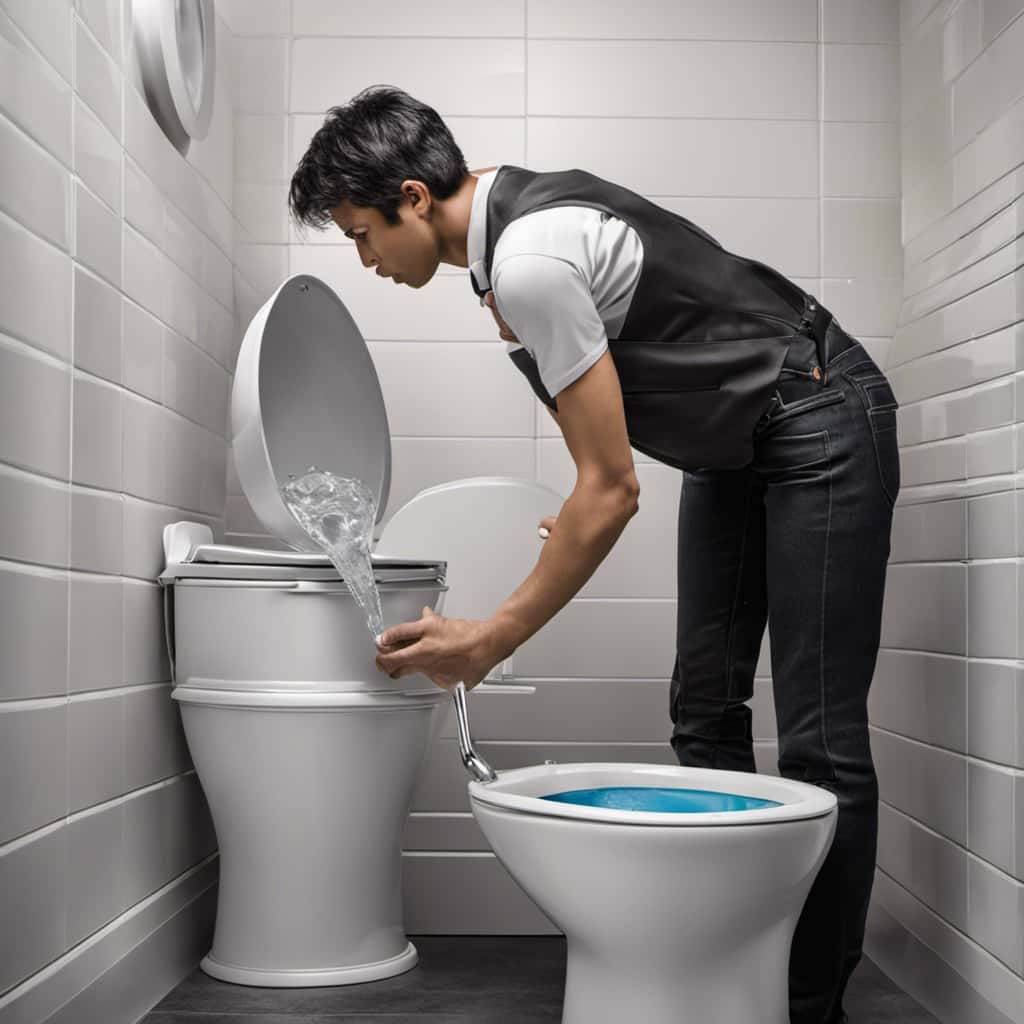
Step-By-Step Guide to Upgrading Your Toilet Flush
Let’s dive into the process of upgrading our toilet flush with a step-by-step guide.
Upgrading your toilet flush can help resolve common problems such as weak flush or constant clogs.
Before beginning the upgrade, turn off the water supply to the toilet.
Start by removing the tank lid and draining the water from the tank.
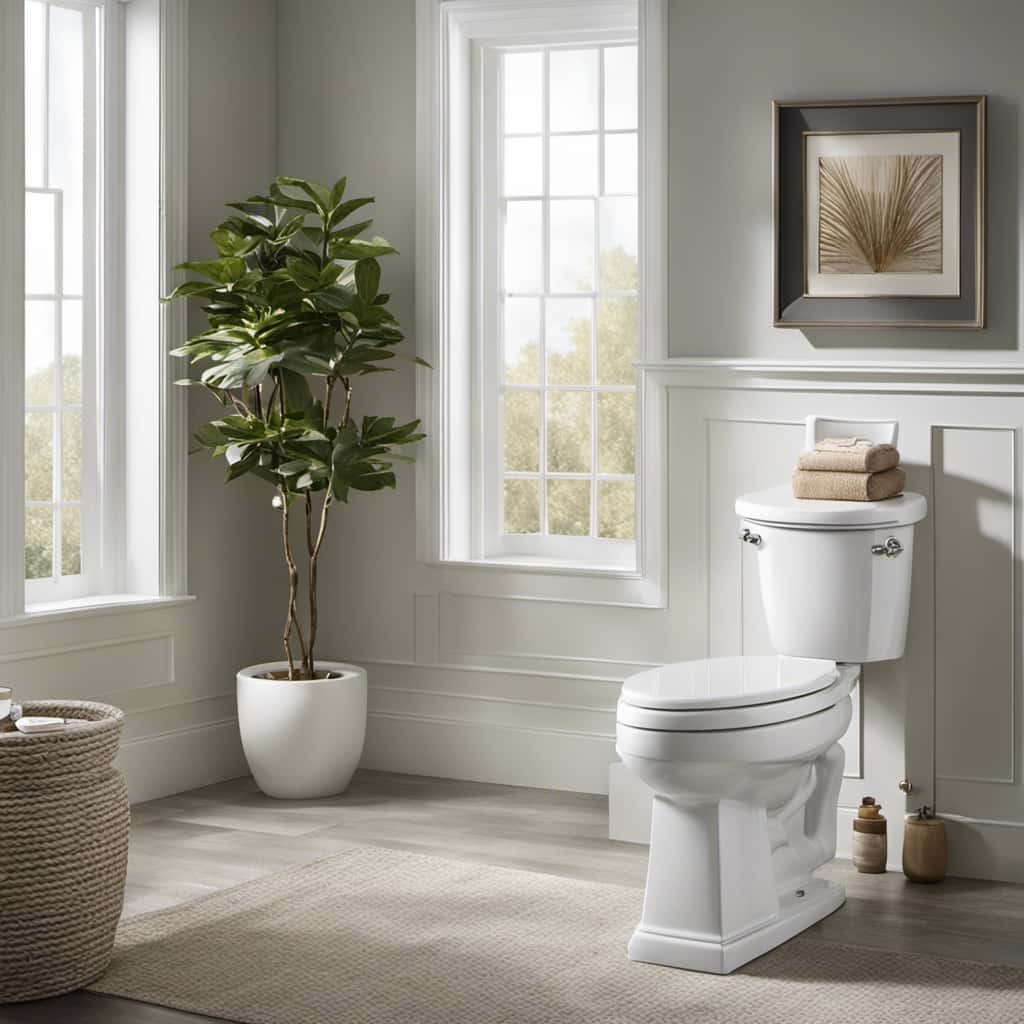
Next, disconnect the supply line from the bottom of the tank and remove any remaining water.
To replace the flush valve, unscrew the locknut and lift out the old valve.
Install the new flush valve by following the manufacturer’s instructions.
Finally, reattach the supply line, turn on the water supply, and test the flush.
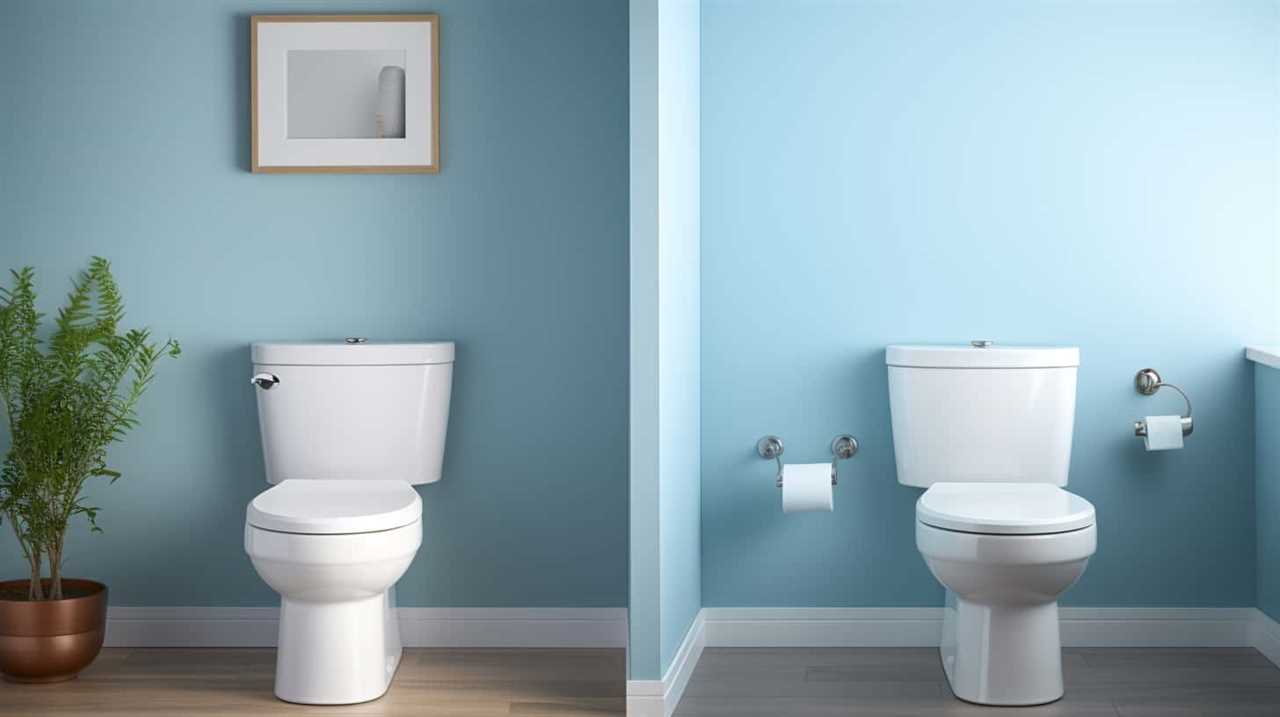
If you encounter any issues, refer to the troubleshooting tips provided by the manufacturer.
Maintenance Tips for Your Upgraded Toilet Flush
To ensure optimal performance, we recommend regular maintenance for our upgraded toilet flush. Proper maintenance will help prevent common problems with upgraded toilet flushes and ensure that your toilet continues to function flawlessly.
Here are some essential maintenance tips to keep in mind:
- Regularly clean the toilet tank and bowl to remove any mineral deposits or debris that may affect the flush mechanism.
- Check for any leaks or drips in the water supply line or flush valve and address them promptly.
- Inspect the flapper valve for any signs of wear or damage and replace it if necessary.
- Adjust the water level in the toilet tank to ensure it’s at the recommended level for your upgraded flush system.
- Periodically test the flush performance and make any necessary adjustments to the flush mechanism.
Frequently Asked Questions
Can I Upgrade My Toilet Flush Myself, or Do I Need to Hire a Professional?
We can upgrade our toilet flush ourselves or hire a professional. DIY toilet flush upgrades can save money and give a sense of accomplishment. Hiring a professional ensures expertise and guarantees a high-quality upgrade.
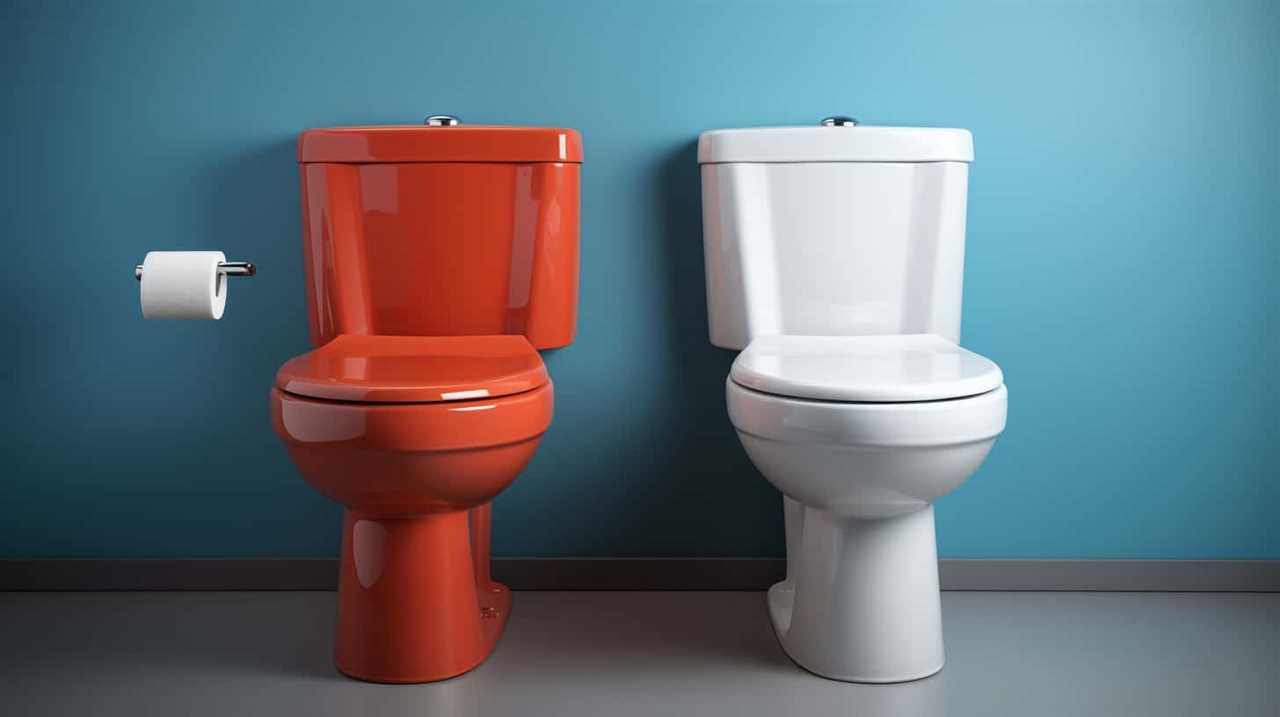
Are There Any Potential Drawbacks or Disadvantages to Upgrading My Toilet Flush?
Potential drawbacks or disadvantages to upgrading a toilet flush include increased water usage, potential leaks or malfunctions, and the need for regular maintenance. It is important to choose a reliable and efficient flush system to minimize these issues.
Will Upgrading My Toilet Flush Save Me Money on My Water Bill?
Upgrading our toilet flush will save money on our water bill. It’s like having a leaky faucet replaced with a high-efficiency model. The water conservation benefits and long-term cost effectiveness make it a wise investment.
Are There Any Specific Brands or Models of Toilet Flush Upgrades That Are Highly Recommended?
There are many top recommended brands and models of toilet flush upgrades that are highly recommended. These upgrades are known for their water efficiency and can help save money on water bills.
How Long Does a Toilet Flush Upgrade Typically Last Before Needing to Be Replaced or Repaired?
Toilet flush upgrades typically last several years before needing replacement or repair. Common issues include leaks, clogs, and malfunctioning mechanisms. Regular maintenance and proper usage can help prolong the lifespan of the upgrade.

Conclusion
Upgrading your toilet flush is like unlocking the hidden potential of your bathroom. It’s like giving your toilet a power boost, allowing it to work more efficiently and effectively. By considering the factors and following the step-by-step guide, you can easily achieve this upgrade.
Don’t forget to maintain your upgraded toilet flush for long-lasting performance. So, go ahead and embark on this journey of improvement, and enjoy the refreshing feeling of a powerful flush every time.
With an impeccable eye for detail and a passion for bathroom-related, Ava leads our editorial team gracefully and precisely.
Under her guidance, Best Modern Toilet has flourished as the go-to resource for modern bathroom enthusiasts. In her free time, you might find Ava exploring antique shops and looking for vintage bathroom fixtures to add to her collection.
FAQ - Advanced Bathroom Queries
Flush Valve

Welcome, fellow plumbing enthusiasts, to our discussion on the amazing flush valve.
With its unassuming presence and understated functionality, the flush valve silently orchestrates the symphony of water flow within our commodes.
As we delve into the inner workings of this unsung hero, we shall uncover the secrets behind its flawless operation, explore its various incarnations, troubleshoot common maladies, and impart maintenance wisdom to ensure its perpetual efficiency.
Prepare to be enlightened, dear readers, for the flush valve holds the key to lavatory perfection.
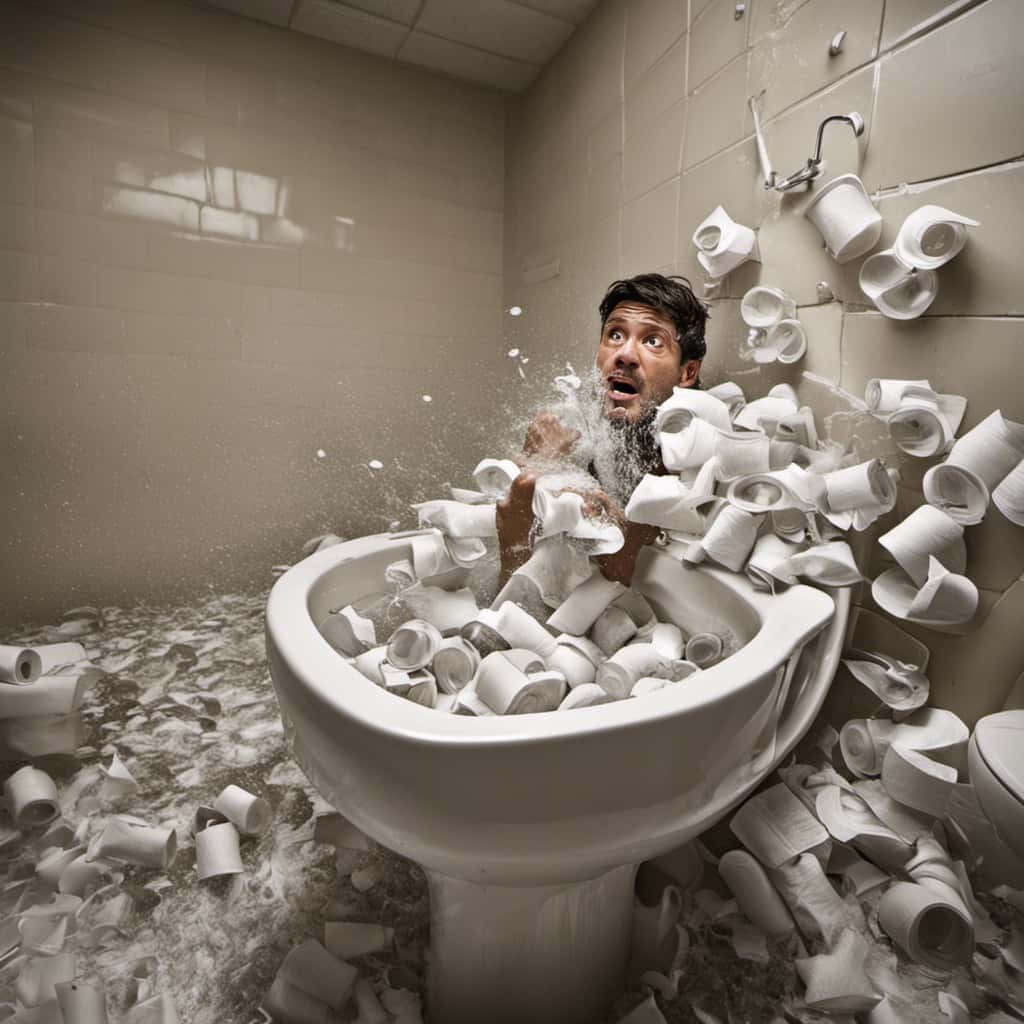
Key Takeaways
- Flush valves efficiently remove waste from the toilet bowl and contribute to proper sanitation and hygiene.
- Dual flush valves offer water conservation by saving water for liquid waste and providing a powerful flush for solid waste.
- Regular maintenance of flush valves prevents debris and mineral buildup, helps identify and address potential issues, and saves time and money on costly repairs.
- Troubleshooting common issues with flush valves, such as weak flushing or continuous running, is an important aspect of maintenance and can often be resolved through inspection and adjustment.
Importance of Flush Valve
The importance of a flush valve lies in its ability to efficiently and effectively remove waste from a toilet bowl. Flush valves play a crucial role in maintaining proper sanitation and hygiene in our bathrooms. But their significance goes beyond just cleanliness.
Flush valves also contribute to water conservation, an increasingly important concern in today’s world. By regulating the amount of water used during each flush, flush valves help optimize water usage and reduce unnecessary wastage. This is particularly evident in dual flush toilets, which offer two flushing options – one for liquid waste and another for solid waste.
The benefits of dual flush toilets are twofold: they not only save water by using less for liquid waste, but also ensure a powerful flush when needed for solid waste. Understanding the importance of flush valves sets the stage for exploring how they actually work.
How Flush Valves Work
Often, we rely on flush valves to efficiently remove waste from a toilet bowl and maintain proper sanitation and hygiene in our bathrooms. The flush valve mechanism is a crucial component that enables this process to happen smoothly.
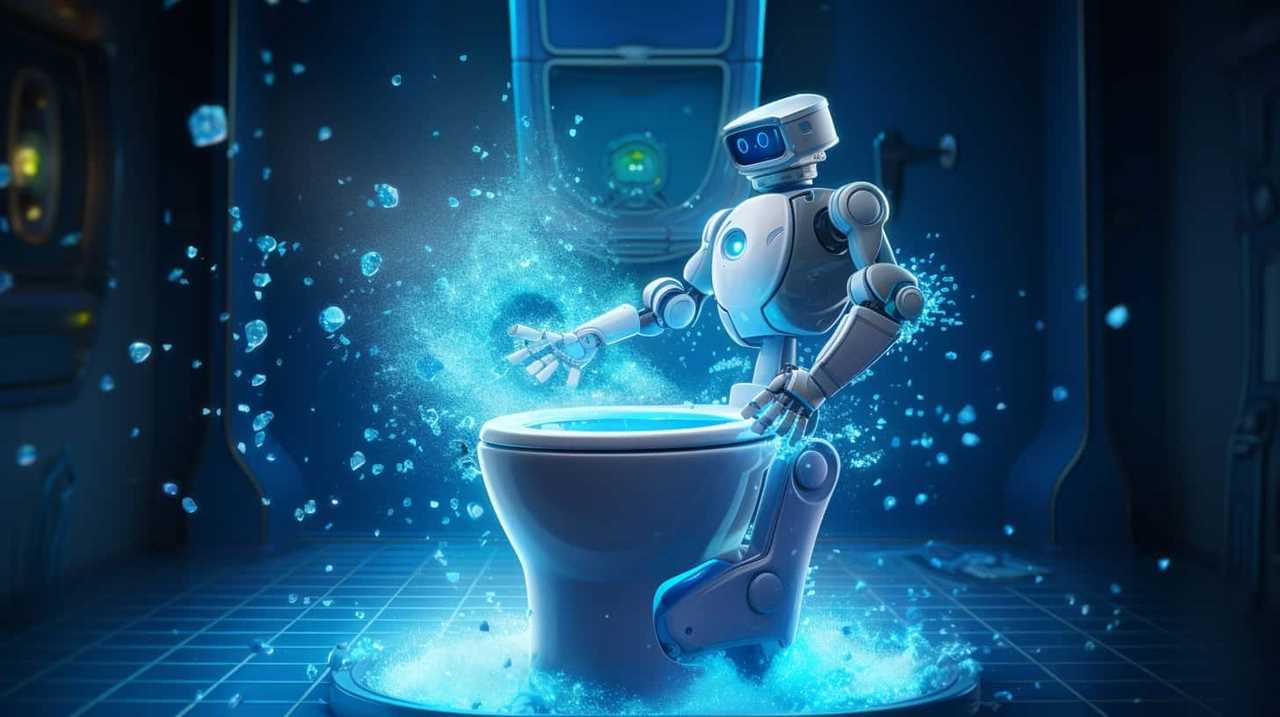
A flush valve typically consists of a valve seat, a valve disc, and a flush lever. When the flush lever is pressed, it lifts the valve disc off the valve seat, allowing water to flow from the tank into the toilet bowl. As the water enters the bowl, it creates a siphon effect that carries away the waste.
The advantages of flush valves include their ability to provide a powerful and thorough flush, preventing clogs and ensuring effective waste removal. They also offer water-saving benefits by allowing for adjustable water volume and controlling the duration of the flush. Additionally, flush valves are durable and require minimal maintenance, making them a reliable choice for commercial and residential applications alike.
Different Types of Flush Valves
After discussing how flush valves work, let’s now delve into the different types of flush valves available in the market. When it comes to flush valve installation, there are two main types to consider: exposed and concealed flush valves.
Exposed flush valves are visible and mounted on the outside of the toilet bowl or urinal, making them easier to access for maintenance and repairs. On the other hand, concealed flush valves are hidden behind the wall or within the toilet fixture, providing a sleek and streamlined appearance.

One popular type of flush valve is the dual flush valve, which offers the benefits of water conservation and efficiency. Dual flush valves allow users to choose between a full flush for solid waste and a partial flush for liquid waste, reducing water usage and saving money on utility bills. This innovative design has gained popularity due to its environmental sustainability and cost-effectiveness.
Common Problems With Flush Valves
As we explore common problems with flush valves, we encounter various issues that can affect their performance and functionality. Here are four common problems you may encounter with flush valves:
- Inadequate flushing: If your flush valve isn’t providing enough water to clear the bowl properly, it may be due to a clog or a faulty flush valve mechanism. Troubleshooting flush valves involves checking for any obstructions in the water flow and ensuring that the flush valve is opening and closing properly.
- Continuous running: If your flush valve keeps running even after the tank is full, it could be a sign of a worn-out flapper or a faulty fill valve. DIY flush valve repairs in this case may involve replacing the flapper or adjusting the fill valve to stop the continuous running.
- Weak flush: A weak flush can be caused by a partially clogged flush valve or a low water level in the tank. Troubleshooting flush valves in this case requires cleaning the valve and adjusting the water level to ensure a strong and effective flush.
- Leaking water: If you notice water leaking from the base of the flush valve or from the tank, it could be due to a worn-out gasket or a loose connection. DIY flush valve repairs for leaks involve replacing the gasket or tightening the connections to prevent water leakage.
Maintenance Tips for Flush Valves
To ensure optimal performance and longevity, regular maintenance is essential for flush valves. Implementing a maintenance routine offers several benefits.
First and foremost, it helps prevent clogs and reduces the likelihood of valve malfunctions. By regularly inspecting and cleaning the valve, you can remove any debris or mineral buildup that may hinder its proper functioning.

Additionally, maintenance allows you to identify and address any potential issues before they escalate, saving you time and money on costly repairs. Troubleshooting common issues is another crucial aspect of maintenance.
If you encounter problems such as weak flushing or continuous running, check the valve’s components, including the flapper, overflow tube, and water supply. A thorough inspection and adjustment can often resolve these issues and restore the valve to its optimal functionality.
Frequently Asked Questions
Can a Flush Valve Be Installed in Any Type of Toilet?
Yes, a flush valve can be installed in any type of toilet. However, it is important to consider the benefits of using a flush valve system and the pros and cons of different types of flush valves.
How Often Should a Flush Valve Be Replaced?
We should replace a flush valve periodically to ensure proper toilet functionality. Signs of a worn-out flush valve include leakage, weak flushing, and constant running water. Regular flush valve maintenance is crucial.
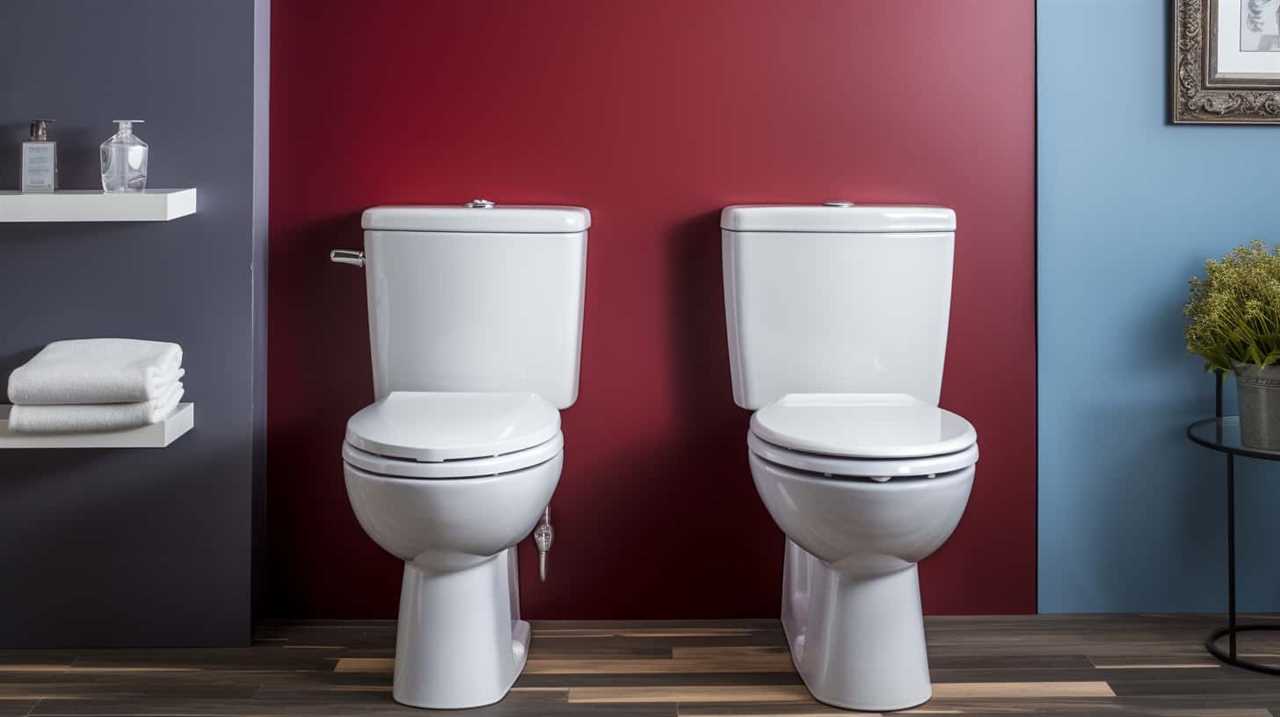
Are There Any Eco-Friendly Flush Valve Options Available?
Yes, there are eco-friendly flush valve options available. These utilize water-saving technology and are made from eco-friendly materials. They are designed to reduce water consumption and promote sustainability in plumbing systems.
Can a Flush Valve Be Repaired, or Does It Need to Be Fully Replaced?
When it comes to repairing flush valves, it’s important to assess the extent of the problem. In some cases, a simple repair can fix common issues like leaks or clogs. However, more severe damage may require a full replacement.
Are There Any Benefits to Using a Dual Flush Valve System?
Using a dual flush valve system has several benefits. It enhances efficiency by allowing users to choose between a full and partial flush, conserving water. This can lead to significant water savings over time.
Conclusion
In conclusion, the flush valve serves as the unsung hero of our daily lives, silently and efficiently ensuring the proper functioning of our toilets.
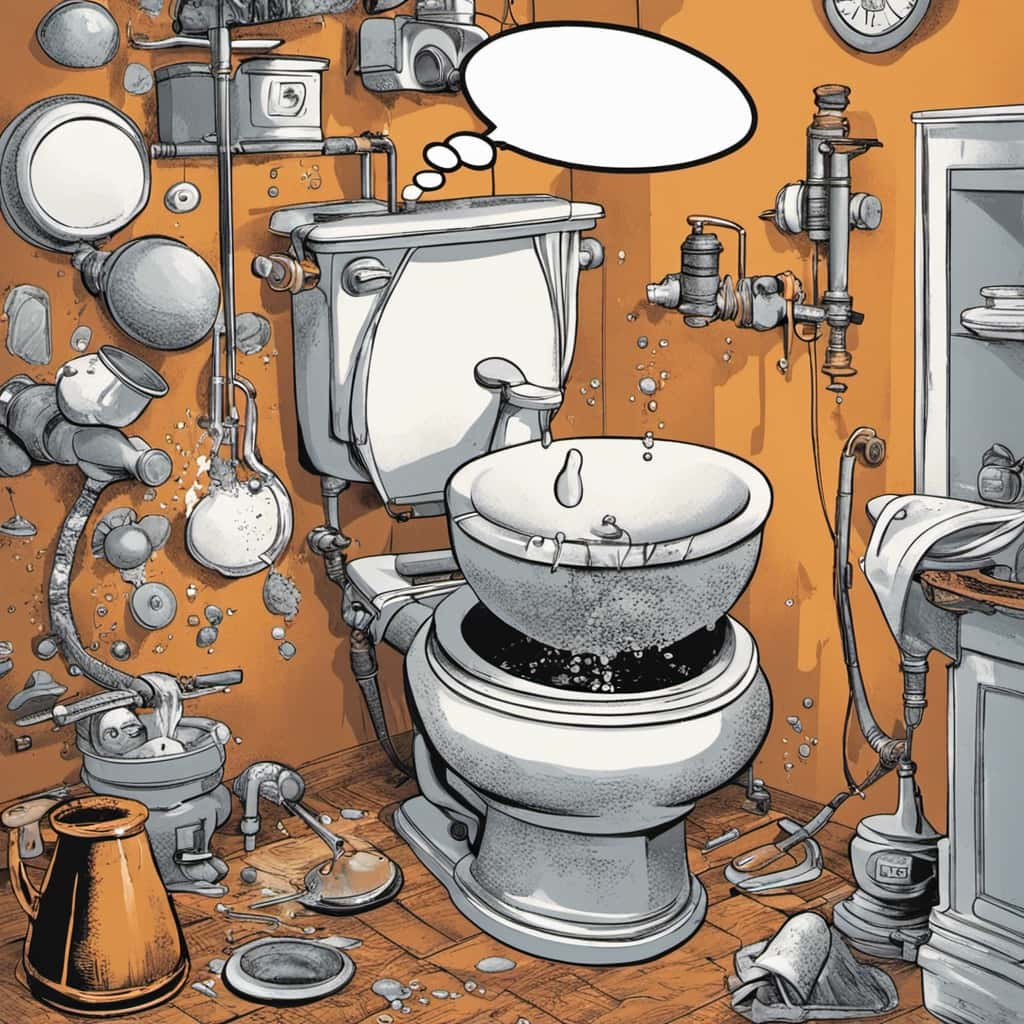
Like a conductor leading an orchestra, it orchestrates the flow of water, symbolizing the harmony and balance within our plumbing systems.
Its intricate mechanisms, from the float to the diaphragm, work in perfect synchronization, guaranteeing a clean and hygienic flush every time.
With regular maintenance and care, this small yet vital device will continue to uphold the standards of cleanliness in our modern world.
With an impeccable eye for detail and a passion for bathroom-related, Ava leads our editorial team gracefully and precisely.
Under her guidance, Best Modern Toilet has flourished as the go-to resource for modern bathroom enthusiasts. In her free time, you might find Ava exploring antique shops and looking for vintage bathroom fixtures to add to her collection.
FAQ - Advanced Bathroom Queries
Why Won’t My Toilet Flush Without Power

If you’ve ever been stuck in a challenging situation during a power outage, frantically trying to figure out why your toilet isn’t flushing, don’t worry – we’re here to explain this common dilemma.
In this article, we’ll explore the role of electricity in toilet flushing and delve into the components of a power-dependent flushing system. We’ll also uncover the reasons behind toilet flushing failure during power outages and provide alternative methods to ensure a functional toilet, even without power.
So, let’s dive in and master the art of flushing without electricity!
Key Takeaways
- Electricity is essential for the flush mechanism of modern toilets.
- Power outages can disrupt the functioning of the components that control flushing.
- Alternative methods for flushing a toilet without power include manually filling the tank, pouring water into the bowl, or using portable toilet options.
- Preparing for power outages involves installing backup power sources, stocking up on water, considering water-saving toilets, and educating oneself on alternative flushing methods.
The Role of Electricity in Toilet Flushing
In our experience, the main role of electricity in toilet flushing is through the operation of the electrically-powered flush mechanism. This mechanism is responsible for initiating the flushing action by activating the water flow and creating the necessary pressure to remove waste from the bowl.

The impact of water pressure on toilet flushing can’t be overstated. Adequate water pressure ensures a strong and efficient flush, while low water pressure can result in incomplete waste removal and potential clogs.
The history of electricity in toilet technology dates back to the early 20th century when electrically-powered flush mechanisms were first introduced. Since then, advancements in technology have led to more efficient and effective flushing systems, improving overall toilet performance.
Understanding the role of electricity in toilet flushing is crucial for maintaining a properly functioning toilet system.
Components of a Power-Dependent Flushing System
To understand the components of a power-dependent flushing system, we need to examine the inner workings of the toilet. Power saving toilet technology has become increasingly popular due to its ability to reduce energy consumption and minimize the impact of power outages on water pressure. Let’s take a closer look at the key components involved in this system.

| Component | Function |
|---|---|
| Flapper valve | Controls the release of water from the tank into the bowl |
| Fill valve | Regulates the water level in the tank |
| Flush valve | Opens to allow water to flow into the bowl during flushing |
During a power outage, the lack of electricity can disrupt the functioning of these components, particularly the flapper valve. Without power, the flapper valve may fail to open, preventing the water from being released into the bowl. Additionally, the fill valve may not be able to replenish the water in the tank, leading to decreased water pressure and a weaker flush. Understanding these components helps us comprehend why a toilet may not flush without power.
Common Reasons for Toilet Flushing Failure During Power Outages
When power outages occur, we often experience toilet flushing failure due to several common reasons. One of the main causes is the reliance on electricity for the flushing mechanisms of modern toilets. These mechanisms, such as electric pumps or pressure-assisted systems, require power to operate. Without electricity, these mechanisms can’t generate the necessary force to flush the toilet effectively.
Another reason for flushing failure during power outages is a clogged or malfunctioning toilet. Blockages in the pipes or a faulty flush valve can impede the flushing process, even when power is available. Troubleshooting toilet flushing issues should involve checking for blockages, ensuring the flush valve is functioning properly, and considering alternative methods for flushing.
Understanding these common reasons for toilet flushing failure is crucial in finding solutions and ensuring proper functionality, especially during power outages. In the next section, we’ll explore alternative methods for flushing a toilet without power.

Alternative Methods for Flushing a Toilet Without Power
During power outages, when the reliance on electricity for toilet flushing mechanisms renders them ineffective, it’s important to consider alternative methods for flushing a toilet without power.
In emergency situations, there are several solutions that can be implemented to ensure proper sanitation and water conservation.
One option is to manually fill the toilet tank with water using a bucket or container. By pouring the water into the bowl, it will create enough force to flush the waste down the drain.
Another method is to use a portable camping toilet or a portable toilet seat that can be placed on top of a bucket or other container.

These emergency solutions can help maintain hygiene and prevent the spread of diseases during power outages, while also conserving water.
Preparing for Power Outages: Tips to Ensure a Functional Toilet
In order to prepare for power outages and ensure a functional toilet, we can continue the discussion by exploring some helpful tips. Here are three key suggestions to enhance toilet hygiene and emergency preparedness:
- Install a backup power source: Consider investing in a generator or a battery backup system to keep essential appliances, including your toilet, running during power outages. This will allow you to maintain proper sanitation even when the electricity is down.
- Stock up on water: Have an adequate supply of water stored for emergencies. You can use this water to manually flush the toilet by pouring it directly into the bowl. Aim for at least one gallon of water per person per day to cover your basic needs.
- Learn manual flushing techniques: Familiarize yourself with alternative methods for flushing the toilet without power. For instance, you can manually fill the toilet tank using a bucket of water to create enough pressure for a flush.
Frequently Asked Questions
How Does a Power Outage Affect the Operation of a Toilet?
During a power outage, a toilet may not flush because it relies on electricity to activate the flushing mechanism. Without power, the backup generator or emergency plumbing may be needed to restore functionality.
Can I Manually Flush a Toilet That Is Dependent on Electricity?
Yes, you can manually flush a toilet that relies on electricity. By using the emergency toilet flush or manually filling the tank and operating the lever, you can still achieve a functioning flush without power.

Are There Any Alternative Methods to Flush a Toilet Without Power?
Emergency toilet solutions include DIY toilet flush options. When there is no power, alternative methods can be used to manually flush a toilet. These methods ensure functionality during emergencies or power outages.
What Are the Common Reasons for Toilet Flushing Failure During a Power Outage?
The common reasons for toilet flushing failure during a power outage include a lack of power to operate the toilet flushing mechanism and potential issues with the water supply. Troubleshooting toilet flushing may involve checking the power source and ensuring proper water flow.
How Can I Prepare My Toilet for a Power Outage to Ensure It Remains Functional?
To prepare our toilet for a power outage and ensure it remains functional, we can take measures such as installing a backup generator, using water conservation techniques, and considering portable toilet options.
Conclusion
In conclusion, power outages can disrupt the functioning of toilets, which rely on electricity for flushing.

One interesting statistic to consider is that during a power outage, the average person flushes the toilet around 2,500 times per year.
This visualizes the potential inconvenience and importance of having alternative methods in place to ensure a functional toilet during such situations.
With an impeccable eye for detail and a passion for bathroom-related, Ava leads our editorial team gracefully and precisely.
Under her guidance, Best Modern Toilet has flourished as the go-to resource for modern bathroom enthusiasts. In her free time, you might find Ava exploring antique shops and looking for vintage bathroom fixtures to add to her collection.
-

 FAQ - Advanced Bathroom Queries2 months ago
FAQ - Advanced Bathroom Queries2 months agoWhich Countries Use Bidets the Most
-

 Reviews3 weeks ago
Reviews3 weeks agoLDian Smart Toilet Review [2024]
-

 Buying Guides3 months ago
Buying Guides3 months agoWhat to Do When You Accidentally Flushed Something Down the Toilet
-

 Reviews3 months ago
Reviews3 months agoBest Toilet Enzyme Cleaners for Optimal Odor Control [2024]
-

 Reviews2 months ago
Reviews2 months agoKohler Innate Smart Toilet Review [2024]
-

 Reviews2 months ago
Reviews2 months agoKohler NUMI 2.0 Smart Toilet Review [2024]
-

 Guides3 months ago
Guides3 months agoWhat Happens if You Pour a Bucket of Water in the Toilet
-

 Toilet Types2 months ago
Toilet Types2 months agoAre Bleach Tablets Bad for Your Toilet





















